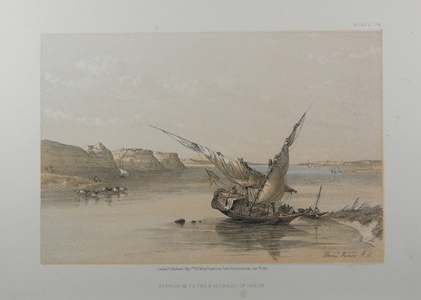| Method | Lithograph with tint stone |
| Artist | after David Roberts |
| Published | London, Published July 1st. 1856, by Day & Son, Gate Street, Lincoln's Inn Fields |
| Dimensions | Image 140 x 208 mm, Sheet 205 x 285 mm |
| Notes |
Plate 174 from Volume 5 of the small format reprint of Roberts' The Holy Land, Syria, Idumea, Arabia, Egypt & Nubia. A view of Nile and the approach to the cliff-top ruins of Qasr Ibrim, in the ancient Egyptian region of Nubia. The settlement of Qasr Ibrim dates to at lest the reign of Amenhotep I, and was an important outpost for Egyptian influence in Nubia, as well as trade in the Aswan region. The site was extended in the Roman era, playing both a strategic and defensive role in Roman administration of the region. At its height, it was the strongest fortress in the Nile Valley, due to its virtually unassailable position atop the cliffs. With the flooding of Lake Nasser by the Aswan Dam in the 1960s, the cliffs of Qasr Ibrim became an island, preserving the archaeological site where many others had to be relocated or abandoned. Roberts' view shows the fortress on the cliffs in the background, the cliffs rising from the Nile. In the foreground, the crew of an Arab felucca ready it to sail, while a small fishing boat unloads nearby. On the opposite bank, a herd of cows wade in the shallows. David Roberts RA (24th October 1796 – 25th November 1864) was a Scottish painter. He is especially known for a prolific series of detailed prints of Egypt and the Near East produced during the 1840s from sketches made during long tours of the region (1838-1840). This work, and his large oil paintings of similar subjects, made him a prominent Orientalist painter. He was elected as a Royal Academician in 1841. The firm of Day & Haghe was one of the most prominent lithographic companies of the nineteenth-century. They were also amongst the foremost pioneers in the evolution of chromolithography. The firm was established in 1823 by William Day, but did not trade under the moniker of Day & Haghe until the arrival of Louis Haghe in 1831. In 1838, Day & Haghe were appointed as Lithographers to the Queen. However, and perhaps owing to the fact that there was never a formal partnership between the two, Haghe left the firm in the 1850's to devote himself to watercolour painting. The firm continued as Day & Son under the guidance of William Day the younger (1823 - 1906) but, as a result of a scandal involving Lajos Kossuth, was forced into liquidation in 1867. Vincent Brookes bought the company in the same year, and would produce the caricatures for Gibson Bowles' Vanity Fair magazine, as well as the illustrations for Cassells's Poultry Book, amongst other commissions. Condition: Light foxing to margins, not affecting image. |
| Framing | unmounted |
| Price | £30.00 |
| Stock ID | 39147 |

